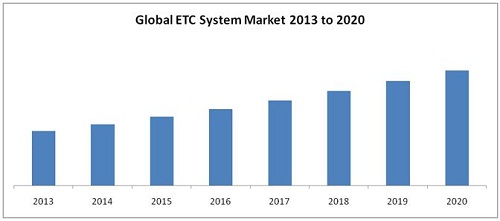The rapid adoption of Electronic Toll Collection system (ETC) is experienced more in the developed countries such as Germany, UK, France, US, and Canada. The ETC system market is gaining traction owing to the several benefits such as improved traffic flow, enhanced public security, increased road safety, and help in protecting environment. It also manages access in urban areas by enforcing and monitoring traffic laws, controlling traffic flows and preventing traffic jams in tunnels. By using ETC system, it is easy to identify passing cars that are enrolled in the system, signals to cars which are not registered, and also electronically debit toll amount from the registered car owner account without stopping them.
One of the key benefits of ETC over manual toll collection is the lessening of time. ETC requires negligible time for the process of toll collection which leads to no traffic disruption for other vehicles moving in the same lane; thereby improving the speed and efficiency of traffic flow and save drivers’ time. Emerging economies are experiencing massive increase in the number of vehicles, causing huge traffic jams. Implementation of ETC will definitely solve such problems which are already being looked upon by countries such as India (Indian Highways Management Company Limited (IHMCL), Thailand, Malaysia, South Africa, and others.
The initial cost of setting up ETC is significantly higher due to complexity of the components, equipment and software installation both in the toll premises as well as in the vehicles. Approximate percentage cost for ETC is to that of manual toll collection is more than 400%. After the setup of ETC, cost of collecting toll electronically (using ETC) is approximately 5-8% of the overall revenue collected, which is the significantly higher.
Electronic Toll Collection is a viable option for the developing countries such as India, China and others with increasing traffic volume; for low the traffic volume countries it is complex process to determine the viability of the ETC, however it is expected that in longer run it helps to control traffic effectively. Electronic Toll Collection system is mainly installed for the ease of transportation. The tolls are collected with the help of electronic equipment installed on the roadside and without reducing the speed of the vehicle. The foremost applications of ETC are on highways and in the urban context of congested cities, which allows to collects toll charges of the registered vehicle without even slowing it.
The rising demand for Electronic Toll Collection systems has shifted focus towards the optimization in the areas such as efficiency, faster service, and lowering the prices. The ETC technologies are generally segmented into radio frequency identification (RFID), dedicated short-range communications (DRSC), video analytics, and global navigation satellite system (GNSS). The two main ETC technology competitions are DSRC and RFID – RFID toll gates which is used in North America, while the DSRC is the standard technology used in Europe and APAC with a mixed position and Short-range (RFID/DSRC) versus wide area (GNSS + Cellular). The future growth is mainly focused on wide area technology. The application of Electronic Toll Collection system is found on Highways and Urban Roads. ANPR (Automatic Number Plate Recognition) also one among the other revolutionary technologies which has started gaining traction in ETC sphere, it helps to recognize the number plate of the vehicle in motion. It is mass surveillance measure that use optical characteristics to identify vehicle registration and transferring information to the control system.
The driving factors behind the rapid upsurge of the ETC market are toll collection without stopping the vehicle, efficient and faster service, minimal halts to pay the toll, and others. The overall ETC market activities are based on two application areas such as highway and urban. Strengthening infrastructure and technological advancements with regard to the ETC also holds the promising potential in the near future. It is being observed that mainly the ETC installations have happened on the highways. Major countries which has significantly employed electronic toll collection system in their infrastructure incudes US, Canada, Germany, UK, France, China Japan and others.
The rising concern for congestion free transportation, fast & error free toll collection, secured toll payment and reducing time at toll station is also fostering the growth of the ETC market. ETC system market is further categorized on the basis of project cost, the hardware market with back office and the integration of all software which covers around 60% of the total project cost of the ETC system. The rest 40% cost is occupied by the other expenses such as manpower, electric wirings, and the construction of the toll plaza.
Key players in this Electronic Toll Collection market are Thales Group (France), EFKON AG (Austria), Kapsch AG (Austria), Hitachi Ltd (Japan), Siemens AG (Germany), MITSUBISHI HEAVY INDUSTRIES LTD (Japan), 3M (U.S.), Q-Free (Norway), Schneider Electric (France), Robert Bosch GmbH (Germany), TransCore (U.K), Xerox Corporation (U.S.) and TRMI Systems Integration (U.S.) and others.
For more detailed information click here



